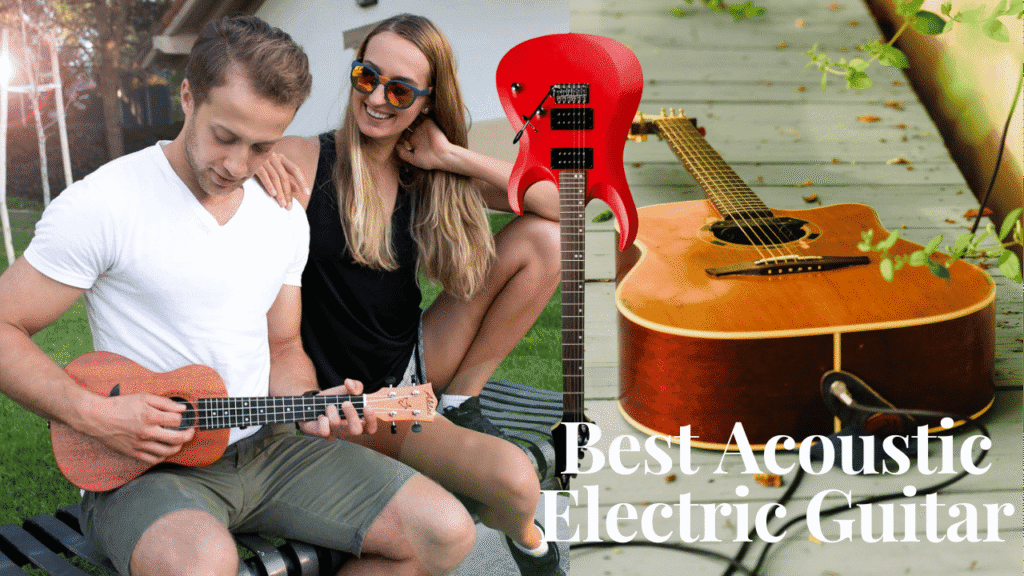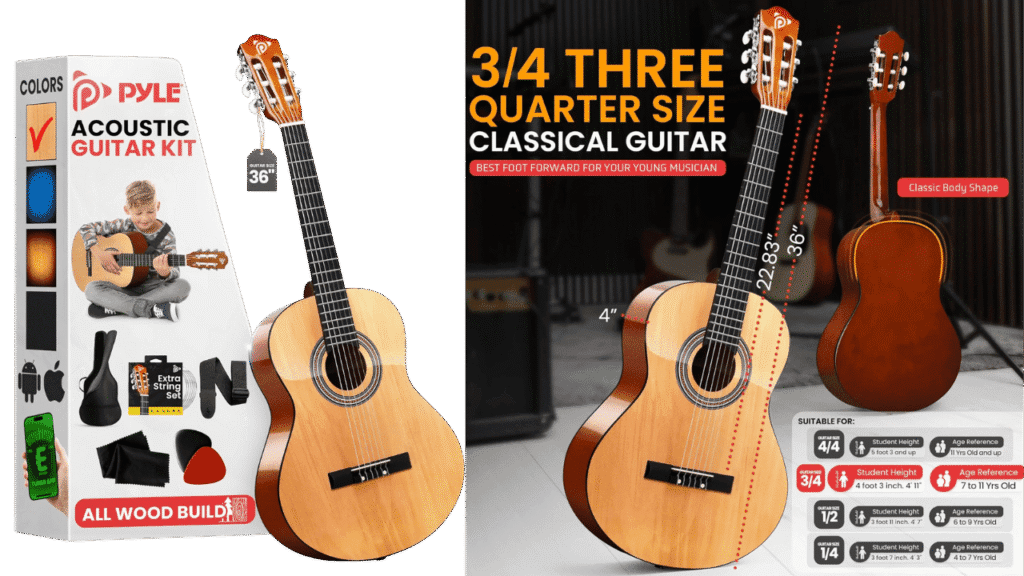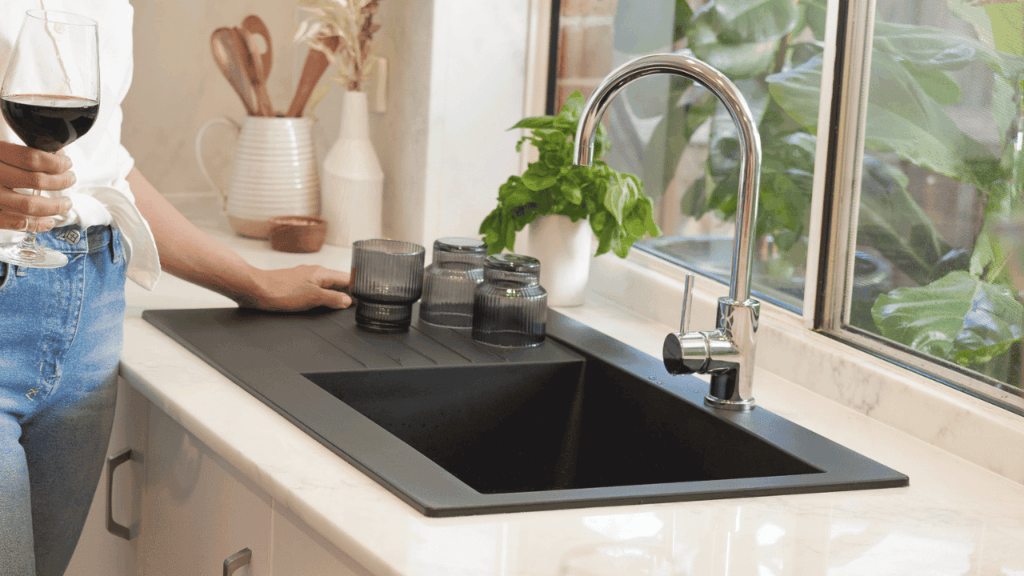Finding the right acoustic electric guitar can change how you play and grow as a musician. These instruments give you the warm tone of an acoustic with the option to plug into an amp.
That makes them perfect for practice, recording, and live shows. This guide covers ten guitars that suit different needs. I focused on playability, sound, electronics, and value. Read on to find the model that fits your goals.

Contents
- 1 Best Acoustic Electric Guitars
- 1.1 1. Aklot Acoustic Electric Guitar
- 1.2 2. Pyle Beginner Acoustic Guitar Kit
- 1.3 3. Luna Tattoo Concert Acoustic Electric Guitar
- 1.4 4. Pyle Acoustic Guitar Kit
- 1.5 5. RockJam Acoustic Guitar
- 1.6 6. Pyle Cutaway Acoustic Electric Guitar
- 1.7 7. Traveler Maple Electric Guitar
- 1.8 8. Pyle Acoustic Electric Cutaway Guitar
- 1.9 9. Lotkey Body Electric Guitar
- 1.10 10. Westcreek Racer Body Electric Guitar
- 2 Buying Guide: What to Look For
- 3 Acoustic Electric Guitars (FAQs)
Best Acoustic Electric Guitars
Our Top Picks
- Aklot Acoustic Electric Guitar
- Pyle Beginner Acoustic Guitar Kit
- Luna Tattoo Concert Electric Guitar
- Pyle Acoustic Guitar Kits
- RockJam Acoustic Guitar
- Pyle Cutaway Acoustic Electric Guitar
- Traveler Maple Electric Guitar
- Pyle Acoustic Electric Cutaway Guitar
- Lotkey Body Electric Guitar
- Westcreek Racer Body Electric Guitar
1. Aklot Acoustic Electric Guitar

The Aklot acoustic electric guitar is a strong option for players on a budget who still want good tone. It usually features a mahogany top and a laminated back. That combo gives a warm midrange and a full low end.
The neck feels slim. New players report fast fretting and easy chord changes. Built-in electronics make it simple to plug into a small amp or PA. The preamp keeps the tone natural and clear. Most Aklot packages include a gig bag, tuner, picks, and extra strings.
That makes it a good starter pack for learners who want to jump into lessons without buying extras. For home practice and small gigs it performs well. For pro stage work you may want a higher-end preamp and pickup. Still, its tone and value make it a popular pick for many players.
Pros
- Warm, balanced tone for its price range
- Slim neck that aids playability
- Often includes starter accessories
Cons
- Preamp is basic for live work
- Laminate top limits acoustic volume
- Not intended for heavy stage use
2. Pyle Beginner Acoustic Guitar Kit

Pyle designs this kit for absolute beginners. The guitar has a standard dreadnought shape that gives bold projection. You can strum with confidence. The neck is smooth and easy to grip for new hands. The kit bundles a soft case, strap, tuner, and picks.
That saves you money and hassle. The built-in pickup and preamp let you plug in for small gatherings or jam sessions. Sound quality is tuned toward clarity and balance rather than tonal nuance. That makes it forgiving for early learners.
Build quality matches the low price. That means it will serve well for years of practice if you treat it with care. If you outgrow it, you can trade up but still keep it as a travel or backup guitar.
Pros
- Complete starter kit included
- Comfortable neck for beginners
- Good value for the price
Cons
- Tone lacks depth for advanced players
- Hardware and electronics are basic
- Limited long-term upgrade potential
3. Luna Tattoo Concert Acoustic Electric Guitar

The Luna Tattoo Concert model blends art and tone. Its decorative top sets it apart on stage. The concert body sits comfortably against your chest. It feels lighter than a dreadnought and handles fingerstyle well. The charted voicing leans bright and articulate.
That helps details cut through in live settings. Luna equips it with a reliable preamp that keeps plugged-in tone close to the acoustic voice. Many players praise its playability for both fingerpicking and light strumming.
The build uses tonewoods that favor mid and high clarity. That means it excels in acoustic band mixes where you need clarity rather than pure volume. If you want a guitar that looks unique and sounds clear, this is a strong choice.
Pros
- Eye-catching design and stage presence
- Clear, articulate tone for fingerstyle
- Comfortable, concert-size body
Cons
- Smaller body gives less low-end power
- Limited projection compared to dreadnoughts
- Few bundled accessories
4. Pyle Acoustic Guitar Kit

This Pyle bundle targets learners who want a no-fuss solution. The dreadnought body provides good projection and an even tonal range. The guitar often ships with a tuner, case, strap, and spare strings.
That makes setup fast so you can focus on practice. The neck profile favors chord shapes and basic lead work. Built-in electronics make it usable on small stages. The overall construction works fine for regular practice and low-key gigs.
Expect basic hardware and entry-level electronics. But for the price the kit covers the essentials well. It fits students and hobbyists who want a single purchase to begin playing right away.
Pros
- Strong projection from the dreadnought body
- Complete beginner bundle included
- Reliable tuning stability for learners
Cons
- Entry-level electronics and hardware
- Tone is solid but not nuanced
- Not aimed at professional players
5. RockJam Acoustic Guitar

RockJam focuses on beginner-friendly instruments with durable builds. This guitar often arrives with a full accessory pack. The dreadnought body delivers strong lows and balanced mids. The neck is forgiving and suits students.
RockJam models often include a simple preamp so you can plug into practice amps or small PA systems. Users praise the solid feel and steady tuning for daily practice. The overall package works hard for the money.
If you play frequently and want a no-nonsense learning tool, RockJam makes a sensible pick. Advanced players may want richer tonewoods, but this model gives new players a dependable platform to learn on.
Pros
- Durable and practical for daily use
- Balanced tone for strumming and chords
- Accessory pack helps beginners start fast
Cons
- Electronics are basic
- Tone lacks the refinement of pricier guitars
- Fewer options for tonal adjustment
6. Pyle Cutaway Acoustic Electric Guitar

The Pyle cutaway model adds a useful design feature for lead players. The cutaway enables easier access to high frets. That makes lead lines and solos more playable. The body still offers decent projection and full tone.
The onboard preamp gives basic tone shaping so you can adjust volume and EQ on stage. Many players like the slim neck and light string tension. Those elements reduce finger fatigue and speed learning. The cutaway mixes comfort with usability.
If you want to work on single-note runs or explore higher-register melodies, this one helps you reach them. It remains an entry-level workhorse rather than a studio instrument.
Pros
- Cutaway for upper fret access
- Comfortable neck for extended practice
- Good plug-in functionality for small gigs
Cons
- Electronics are simple compared to pro-grade preamps
- Build materials remain budget-oriented
- Not ideal for loud acoustic-only settings
7. Traveler Maple Electric Guitar

Traveler guitars aim to keep music on the road. This maple-bodied model shrinks the profile while preserving a musical voice. The design uses compact body and full fretboard spacing so you can play normally.
Maple brings a crisp, clear tone with strong note definition. The small size reduces acoustic projection, but the plugged tone stays full thanks to a good pickup system. This guitar shines for musicians who tour or commute.
It fits overhead bins, tight cars, or studio booths. The solid tuning stability and sturdy hardware make it road-ready. Expect a higher price for the travel convenience, but the design pays off for frequent movers.
Pros
- Highly portable without losing playability
- Clear, bright maple tone
- Strong tuning stability for travel
Cons
- Smaller body reduces natural volume
- Price can be higher than comparable full-size models
- Less warmth than mahogany or spruce tops
8. Pyle Acoustic Electric Cutaway Guitar

This Pyle variant combines cutaway access with plug-and-play convenience. It targets players who want a practical stage setup without a steep price. The preamp supports basic EQ adjustments and keeps plugged tone true to the acoustic sound.
The cutaway helps lead work. The body shape still maintains enough low end for robust strumming. The neck stays lean and playable for most hand sizes. This model suits students and gigging beginners who need a reliable, affordable tool.
Expect serviceable materials and components. But the overall package gives good value and covers the most important needs of a practicing musician.
Pros
- Cutaway for upper fret comfort
- Affordable amplified performance
- Good balance between playability and projection
Cons
- Tonal detail lags behind mid-range guitars
- Hardware may need upgrades over time
- Limited onboard controls
9. Lotkey Body Electric Guitar

Lotkey offers a distinctive design and a different feel from standard acoustics. Many Lotkey models use Okoume or similar tonewoods. That wood gives a balanced and slightly bright tone with good sustain.
The guitar often ships with nylon strings, which feel soft on the fingers. Nylon strings suit fingerstyle players and learners who prefer gentler tension. The electronics support studio or small-stage needs.
The modern look appeals to players who value aesthetics alongside sound. You may need minor setup work at purchase to optimize intonation. Overall, it’s a solid choice for style-minded players and casual performers.
Pros
- Unique look and stage presence
- Comfortable nylon string feel for beginners
- Balanced tonal response
Cons
- May require setup for best playability
- Brand recognition is lower than mainstream makers
- Not aimed at loud, large-venue shows
10. Westcreek Racer Body Electric Guitar

Westcreek’s racer body brings a bold visual style to acoustic-electric play. The shape helps access high frets and offers a different ergonomic feel. The guitar tends to focus on bright, cutting tones that work well with pick-driven styles.
The neck allows fast position changes and fluid solos. The electronics provide solid amplification for small venues and recording. The build quality leans toward durable designs so you can play often without worry.
This model appeals to players who want a standout look and reliable function. It pairs well with modern acoustic and hybrid styles.
Pros
- Distinctive racer-style look
- Fast, responsive neck for lead work
- Durable construction for regular use
Cons
- Bright tone may not suit all styles
- Slightly heavier feel for some players
- Limited accessory bundles
Buying Guide: What to Look For
Choosing the best acoustic electric guitar comes down to a few key factors. Keep this checklist in mind when you shop.
Tonewood and Body Shape:
Tonewoods shape the voice. Mahogany gives warmth. Spruce adds bright clarity. Maple offers snap and definition. Dreadnoughts project loud and full. Concert and parlor bodies feel smaller and suit fingerstyle.
Neck and Playability:
A slim neck helps beginners and players with smaller hands. A cutaway helps reach high frets. Check the neck profile and fretboard radius before you buy.
Electronics:
Look for a reliable preamp and pickup. Simple volume and tone knobs work. More advanced units add built-in tuners and EQ sliders. Test the plugged-in tone to avoid unpleasant feedback or thin sound.
Construction and Durability:
Solid tops sound better and age well. Laminates handle humidity and travel. Check bridge and nut quality. Good hardware reduces tuning issues.
Accessories and Value:
Starter kits help new players. Cases, tuners, straps, and spare strings add value. Think about where you will play and what extras you need.
Also Read: Best Tire Inflator Portable Air Compressors

Acoustic Electric Guitars (FAQs)
Should a beginner buy an acoustic electric or a standard acoustic?
An acoustic electric gives more options. You can play unplugged at home and plug in for performances. It adds flexibility for practice and gigs.
Do acoustic electric guitars need batteries?
Many preamps use a 9V battery. Some models use rechargeable modules. Check the preamp specs for power details.
What body shape is best for strumming?
Dreadnought bodies offer the most projection and bass. They work well for strumming and full-band situations.
How much should I spend as a beginner?
Good beginner acoustic electrics usually fall in the $100–$400 range. Kits in that range often include useful accessories.
Can I upgrade electronics later?
Yes. You can install higher-end pickups and preamps if you want better stage sound as you progress.
Pick the guitar that fits your hands, style, and budget. Starter kits like Pyle make learning easy. Travel guitars shine for on-the-road players. Models like Aklot and Luna blend tone and playability for the price. Test a few if you can. Choose the one that inspires you to play.



